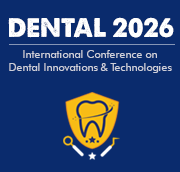Title : Comparative effectiveness of probiotics versus fluoride in preventing dental caries in patients undergoing orthodontic treatment: A systematic review
Abstract:
Aim of this study was to determine the effectiveness of probiotics compared to fluoride in preventing dental caries for patients undergoing orthodontic treatment. A literature analysis was conducted using PRISMA guidelines. This search was performed up to September 6th, 2024, using the following terms: “probiotics”, “fluoride”, “dental caries”, “orthodontic treatment”, “caries prevention” in online databases PubMed, Google Scholar, ScienceDirect, Cochrane Library. A focus question based on PICO was formed: Are probiotics more effective than fluoride in preventing dental caries in patients undergoing orthodontic fixed appliance treatment? Inclusion criteria: randomized controlled trials, in-vivo studies, full-text research articles in the English language, research articles published less than 5 years ago.
The initial search yielded 2591 results. Studies that specifically investigated the association between fluoride and probiotics in the context of caries prevention for patients undergoing orthodontic treatment were selected for further analysis. After the selection criteria were applied, 5 studies were included in this review. All of the studies were randomized controlled trials, in-vivo studies. The follow-up periods were as follows: 14 days, 30 days, 6 months. A total of 303 patients participated in the conducted studies. Studies were executed using fluoride or probiotic mouthwash, dentifrice containing probiotic or fluoride, probiotic curd. Plaque samples were collected from study participants to compare the effectiveness of fluoride and probiotics by measuring S.mutans counts, as well as evaluating white spot lesions (WSLs). The results showed that Dadgar S. et al. (2021) and Nisha D. S. N. et al. (2023) found no significant difference between fluoride and probiotics in reducing Streptococcus mutans counts, suggesting equivalent antimicrobial effects. In another study by Mueez Bashir S. et al. (2019), a 44.5% decrease in Streptococcus mutans colonies around brackets was observed 30 days after using fluoride toothpaste, whereas the use of probiotic curd led to a mere 0.86% reduction, highlighting the superior efficacy of fluoride toothpaste (P < 0.01). However, two studies demonstrated that probiotics were more efficient than fluoride at reducing bacterial levels (Goyal N. et al., 2019) and preventing white spot lesions (Tiwari A. and Jain R. K., 2023). In fluoride mouthwash group, there was an increase (p=0.129) in P.gingivalis count at two different intervals T1 and T2, while in probiotic mouthwash group, there was a significant decrease in P.gingivalis count at 1% significance level (P<0.000). In another study, Tiwari A. and Jain R. K. (2023) used the conical tip of the DD-Pen to record the occurrence and severity of white spot lesions on the enamel of the tooth nearest to the bracket. Following a 6-month period, the incidence of WSLs was notably higher in the fluoride dentifrice group (46.37%) than in the probiotic dentifrice group (20.37%), indicating that the probiotic-containing dentifrice was associated with the lowest incidence of WSLs.
Both probiotics and fluoride effectively reduce S.mutans, but only probiotics can decrease P.gingivalis. When considering the formation of white spot lesions, probiotics outperform fluoride, making them a preferable choice for preventing dental caries in patients undergoing orthodontic treatment.



